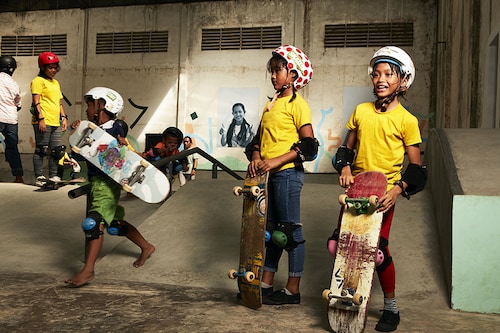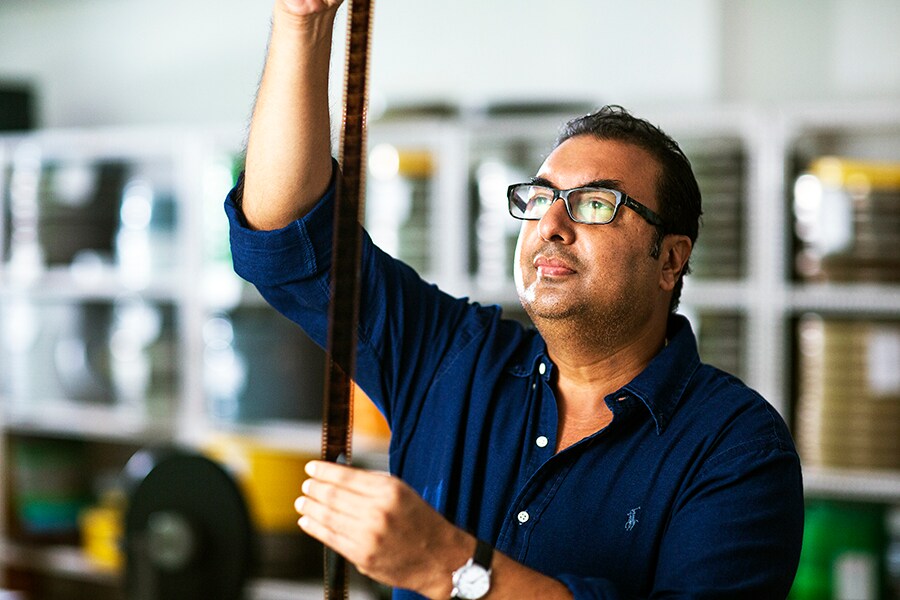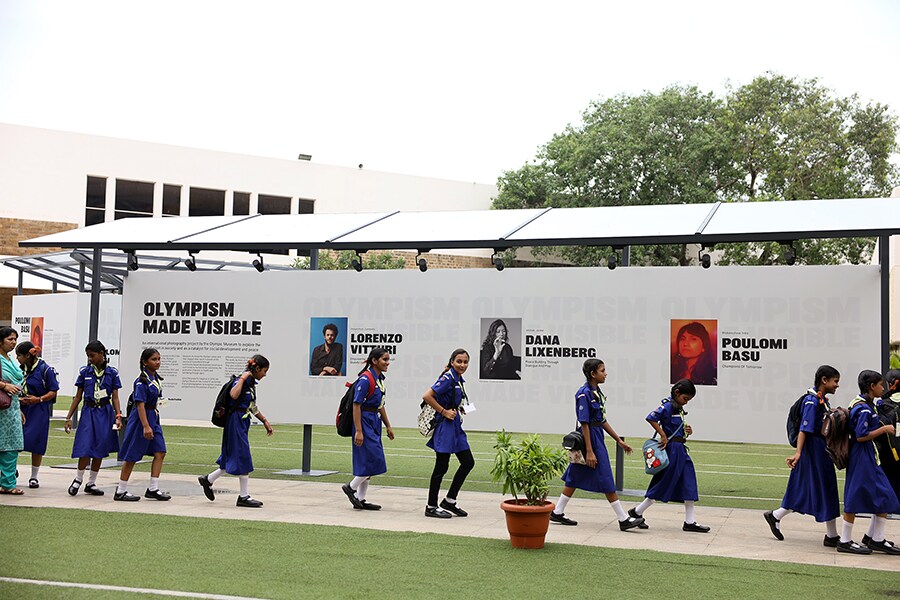The spirit of Olympics, through art and films
Days before the International Olympic Committee session in Mumbai, the first in 40 years, a first-of-its-kind exhibition retrospective showcases the Olympic movement through films and photographs


One morning in 2018, Lorenzo Vitturi was waiting at a warehouse in Phnom Penh to shoot a series with Skateistan, a Berlin-headquartered NGO that empowers underprivileged kids through skateboarding and education. The Italian artist-sculptor-photographer was sent to the Cambodian capital by the International Olympic Committee (IOC) for its Olympism Made Visible project, an international fine arts photography initiative led by the Olympic Museum to capture the transformative power of sport beyond the quadrennial Games.
“As I was waiting, my thoughts were broken all of a sudden by the arrival of 50 children running and screaming," says Vitturi, as he recalls the moment vividly while speaking to Forbes India in Mumbai. “There was an explosion of joy and movement around me—the instructors tried to control them, but it was impossible. They straight got to the boards and started to skate. I am not a sports photographer, but that was the day I really got to know how sports can empower."
Vitturi’s series, along with that of Dutch photographer Dana Lixenberg, who captured through her lens the integration of Syrian refugees into the Jordanian society through the work done by Amman-based Generations for Peace, is on display at the National Centre for Performing Arts (NCPA) in Mumbai as part of a first-of-its-kind exhibition retrospective in India. Christened ‘Olympics in Reel Life’ and presented by the Film Heritage Foundation in partnership with The Olympic Museum in Lausanne (Switzerland), it will also showcase 33 iconic films and 10 series from the Olympic Channel.
The exhibition premieres the works of Poulomi Basu, the only Indian among the 12 photographers commissioned by the IOC, who explored the influence of sports on children at public schools in Odisha’s Bhubaneswar, enrolled with the Olympic Values Education Programme (OVEP), an international educational initiative designed by the IOC. The OVEP was officially launched in India in 2022 in association with the Abhinav Bindra Foundation, a non-profit launched by Bindra, the Olympic champion shooter.
Housed at the NCPA till October 7, the Olympics in Reel Life exhibition will then travel to the India International Centre in Delhi, where it will be on till October 14. While in Mumbai, a photo series on Indians in the Olympics will also be on display at public places, including Dadar Chowpatty, the Colaba Woods Garden and the August Kranti Maidan.
 Shivendra Singh Dungarpur, filmmaker-archivist and the founder of the Film Heritage Foundation
Shivendra Singh Dungarpur, filmmaker-archivist and the founder of the Film Heritage Foundation
The idea of the event was seeded around February, when the IOC began conversations with Shivendra Singh Dungarpur, filmmaker-archivist and the founder of the Film Heritage Foundation, to put together an exhibition that would complement the build-up to the IOC session to be held in Mumbai beginning October 14. (This is the first time since the Delhi edition in 1983 that the IOC session is being held in the country.)
“I got interested because, some years ago, I had shot with Milkha Singh and he wanted me to find some footage of him racing. And I couldn’t find all the footage anywhere," says Dungarpur. “That"s when I realised this heritage has to be kept safe and shown to the people. When you see some of these films like Olympia (Leni Riefenstahl’s documentary on the 1936 Berlin Olympics) or films of Kon Ichikawa on the 1964 Tokyo Olympics, you can feel the human endeavour that is sports."
Basu, whose work has been unveiled at the event, recalls how Olympism manifested itself among her subjects—primarily women from marginalised communities—in Odisha’s schools. Through her work, inspired by magical realism, she tries to portray them as “powerful, confident protagonists" who own their space. “When they hear the word Olympics, they get excited because they believe it can help them rise above their backgrounds and make a mark. In this situation, sport becomes a powerful way for them to feel empowered, especially for girls who often see education as their main way to freedom," she says.
Blending art and sport was originally envisioned by Baron Pierre de Coubertin—who introduced the modern Olympic Games in 1896—who wanted the Olympic spirit to be a way of life, transcending the realm of sport. As a result, art and culture was introduced at the 1912 Stockholm Olympics and medals awarded in five categories: Architecture, literature, music, painting and sculpture. USA’s Walter Winans demonstrated the coming together of the two disciplines in their highest form when he became an Olympic champion in sculpture just four days after he won the gold in shooting. “While art was discontinued post-1949," says Yasmin Meichtry, the associate director of the Olympic Museum, “at the Olympic museum we perpetuate the thinking that through arts and culture, you can also forward and transmit the Olympic values of respect, friendship and excellence."
It’s with this thought, adds Meichtry, that the IOC commissioned the Olympism Made Visible series to see how sports can empower people struggling in life. The IOC felt that if documented with an artistic perspective, the message would be transmitted in a more interesting and compelling way. The photographers they collaborated with, thus, aren’t photojournalists or known for their proficiency in capturing on-field action, but for their fine art photography.
“While I have photographed athletes before," says Lixenberg, who worked with the Syrian refugees in Jordan, “it was more in a way how I would make portraits of other people. Here too, I was looking for some essence which I could connect with." At the Generations for Peace centres, Lixenberg looked not for tales of trauma, but for portraits that would make the children visible in their own place. “Everybody needs validation. If you"re a top athlete and you"re winning medals in the Olympics, that"s the ultimate. But for these children, it is to learn to assert themselves, to be a part of society and not to be invisible. And, as a photographer, you make something visible," she says.
 Local schoolkids visit the exhibition at the NCPAImage:NCPA
Local schoolkids visit the exhibition at the NCPAImage:NCPA
The exhibition comes at a time when India"s Olympic movement is gathering steam, buoyed by a rich haul of medals the athletes are garnering on the world stage. The tally in the ongoing Asian Games, at 81 and counting, has already surpassed previous records. The charge is led by javelin-thrower Neeraj Chopra who, at 25, has won the most marquee of World events—Olympics, the Commonwealth Games, the Asian Games, the World Championships and the Diamond League. “It"s an amazing marker for me as a sports administrator, where that whole notion of ‘Indians take longer to develop’ is not true anymore," says Manisha Malhotra, who represented India in tennis at the 2000 Sydney Olympics and now heads sports excellence and scouting at JSW Sports.
Malhotra senses the switch flicked in 2008, at the Beijing Olympics, when Bindra won the country’s first ever individual Olympic gold. “I had asked a young Saina Nehwal, all of 17-18 then, what she expected from her first Olympics, and I had expected her to say it would be an experience. But she replied that it would be a disappointment if she didn’t win. That’s when the mindset began to change," says Malhotra.
Bindra is now associated with the IOC as a representative of the athletes’ commission and leads his non-profit that, among other things, is attempting to take the spirit of Olympics, which fosters inclusivity and equality, beyond those who play professional sports. “The Olympic Games is much more than a sporting event. It’s a movement based on values. The cultural and heritage side plays a significant role in the promotion of these values while also inspiring millions," he says. “That’s why the film and photography exhibition is significant and I’m delighted it’s being held in Mumbai and Delhi."
Dungarpur recalls an anecdote that actor Amitabh Bachchan recounted, of being one among only two Indians (the other being his friend) in a packed stadium cheering on PT Usha in the Los Angeles Olympics of 1984. “Look at where we’ve come now," he says. “Films, photography, art, everything has contributed to that, because youngsters see these and get inspired. These teach them that sports is not just about winning, it’s about values."
First Published: Oct 05, 2023, 11:36
Subscribe Now